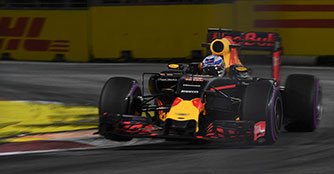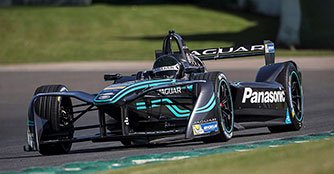10 things that differentiate Formula E from Formula One
18 Oct 2016|8,616 views
If both Formula One and Formula E were food, they would be chai tow kway (carrot cake), with the former being the standard white and the latter being the sweeter black. But like the two mouth-watering dishes, there are some differences between Formula E and Formula One. Here are 10 of them:
1. A Formula One team has two drivers with one car each. However, a Formula E team has two drivers with two cars each. This is to ensure Formula E drivers can last the 50-minute race as each car is only charged with 30 minutes of battery juice.
2. A Formula E driver changes to his second car during his pit stop. Charging of the race cars or tyre changes, unless caused by a puncture or damage, are not permitted during this pit stop. In a Formula One race, drivers make pit stops with the primary purpose of changing tyres or if minor repair work is needed on the car.
3. Formula E fans can be part of the race via FanBoost, which asks fans to vote for their favourite top three drivers in order for the drivers to receive a 100kJ of surge energy, which is equivalent to 3.3 seconds that can be used during the race. Fans of Formula One, on the other hand, can 'take part' in the race through a more traditional method - cheering.
4. There is a total of a record-breaking 21 races for the 2016 Formula One season. Formula E, on the other hand, has only 12 races this season.
5. A Formula One driver covers an average distance of 300 kilometres in a single race. However, a Formula E driver typically covers a much shorter distance of between 90km and 150km.
6. Formula E cars use 18-inch rims, fitted with Michelin tyres with treads that are suitable for both wet and dry conditions. However, this is a stark contrast to Formula One, where the race cars run on 13-inch rims, attached with Pirelli's slicks or wet tyres, depending on the weather condition.
7. An F1 car typically takes about 1.7 seconds to finish the century sprint, compared to a Formula E race car's 3.0 seconds.
8. The Formula One Grand Prix runs over three days, with practice and qualifying sessions on Fridays and Saturdays, and the actual race on Sunday. Formula E, conversely, completes two practice sessions of 45 and 30 minutes respectively, qualifying and the race showdown all in one day.
9. Both Formula One and Formula E drivers score points using the standard FIA system, which sees 1st place receiving 25 points, 2nd place receiving 18 points, 3rd place receiving 15 points and the 10th place receiving one. However, in Formula E, a twist is added whereby three points are also awarded to the driver securing pole position, whilst the driver setting the fastest lap receives an additional point.
10. The average noise level for a Formula E race car is 80 decibels (dB), which is roughly the level of sound made by your average vacuum cleaner. This is far quieter than the 134dB made from a Formula One race car.
If both Formula One and Formula E were food, they would be chai tow kway (carrot cake), with the former being the standard white and the latter being the sweeter black. But like the two mouth-watering dishes, there are some differences between Formula E and Formula One. Here are 10 of them:
1. A Formula One team has two drivers with one car each. However, a Formula E team has two drivers with two cars each. This is to ensure Formula E drivers can last the 50-minute race as each car is only charged with 30 minutes of battery juice.
2. A Formula E driver changes to his second car during his pit stop. Charging of the race cars or tyre changes, unless caused by a puncture or damage, are not permitted during this pit stop. In a Formula One race, drivers make pit stops with the primary purpose of changing tyres or if minor repair work is needed on the car.
3. Formula E fans can be part of the race via FanBoost, which asks fans to vote for their favourite top three drivers in order for the drivers to receive a 100kJ of surge energy, which is equivalent to 3.3 seconds that can be used during the race. Fans of Formula One, on the other hand, can 'take part' in the race through a more traditional method - cheering.
4. There is a total of a record-breaking 21 races for the 2016 Formula One season. Formula E, on the other hand, has only 12 races this season.
5. A Formula One driver covers an average distance of 300 kilometres in a single race. However, a Formula E driver typically covers a much shorter distance of between 90km and 150km.
6. Formula E cars use 18-inch rims, fitted with Michelin tyres with treads that are suitable for both wet and dry conditions. However, this is a stark contrast to Formula One, where the race cars run on 13-inch rims, attached with Pirelli's slicks or wet tyres, depending on the weather condition.
7. An F1 car typically takes about 1.7 seconds to finish the century sprint, compared to a Formula E race car's 3.0 seconds.
8. The Formula One Grand Prix runs over three days, with practice and qualifying sessions on Fridays and Saturdays, and the actual race on Sunday. Formula E, conversely, completes two practice sessions of 45 and 30 minutes respectively, qualifying and the race showdown all in one day.
9. Both Formula One and Formula E drivers score points using the standard FIA system, which sees 1st place receiving 25 points, 2nd place receiving 18 points, 3rd place receiving 15 points and the 10th place receiving one. However, in Formula E, a twist is added whereby three points are also awarded to the driver securing pole position, whilst the driver setting the fastest lap receives an additional point.
10. The average noise level for a Formula E race car is 80 decibels (dB), which is roughly the level of sound made by your average vacuum cleaner. This is far quieter than the 134dB made from a Formula One race car.
Thank You For Your Subscription.






















